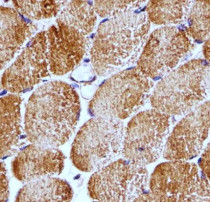ARG58914
anti-Raptor antibody
anti-Raptor antibody for IHC-Formalin-fixed paraffin-embedded sections,Western blot and Human,Mouse,Rat
Overview
| Product Description | Mouse Monoclonal antibody recognizes Raptor |
|---|---|
| Tested Reactivity | Hu, Ms, Rat |
| Tested Application | IHC-P, WB |
| Host | Mouse |
| Clonality | Monoclonal |
| Clone | 1411CT316.2.151.34 |
| Isotype | IgG1, kappa |
| Target Name | Raptor |
| Antigen Species | Human |
| Immunogen | Recombinant protein corresponding to aa. 1005-1329 of Human Raptor. |
| Conjugation | Un-conjugated |
| Alternate Names | Regulatory-associated protein of mTOR; p150 target of rapamycin; TOR; KOG1; Mip1; Raptor |
Application Instructions
| Application Suggestion |
|
||||||
|---|---|---|---|---|---|---|---|
| Application Note | * The dilutions indicate recommended starting dilutions and the optimal dilutions or concentrations should be determined by the scientist. | ||||||
| Positive Control | HeLa |
Properties
| Form | Liquid |
|---|---|
| Purification | Purification with Protein G. |
| Buffer | PBS and 0.09% (W/V) Sodium azide. |
| Preservative | 0.09% (W/V) Sodium azide. |
| Storage Instruction | For continuous use, store undiluted antibody at 2-8°C for up to a week. For long-term storage, aliquot and store at -20°C or below. Storage in frost free freezers is not recommended. Avoid repeated freeze/thaw cycles. Suggest spin the vial prior to opening. The antibody solution should be gently mixed before use. |
| Note | For laboratory research only, not for drug, diagnostic or other use. |
Bioinformation
| Database Links |
Swiss-port # Q8N122 Human Regulatory-associated protein of mTOR |
|---|---|
| Gene Symbol | RPTOR |
| Gene Full Name | regulatory associated protein of MTOR, complex 1 |
| Background | This gene encodes a component of a signaling pathway that regulates cell growth in response to nutrient and insulin levels. The encoded protein forms a stoichiometric complex with the mTOR kinase, and also associates with eukaryotic initiation factor 4E-binding protein-1 and ribosomal protein S6 kinase. The protein positively regulates the downstream effector ribosomal protein S6 kinase, and negatively regulates the mTOR kinase. Multiple transcript variants encoding different isoforms have been found for this gene. [provided by RefSeq, Sep 2009] |
| Function | Involved in the control of the mammalian target of rapamycin complex 1 (mTORC1) activity which regulates cell growth and survival, and autophagy in response to nutrient and hormonal signals; functions as a scaffold for recruiting mTORC1 substrates. mTORC1 is activated in response to growth factors or amino acids. Growth factor-stimulated mTORC1 activation involves a AKT1-mediated phosphorylation of TSC1-TSC2, which leads to the activation of the RHEB GTPase that potently activates the protein kinase activity of mTORC1. Amino acid-signaling to mTORC1 requires its relocalization to the lysosomes mediated by the Ragulator complex and the Rag GTPases. Activated mTORC1 up-regulates protein synthesis by phosphorylating key regulators of mRNA translation and ribosome synthesis. mTORC1 phosphorylates EIF4EBP1 and releases it from inhibiting the elongation initiation factor 4E (eiF4E). mTORC1 phosphorylates and activates S6K1 at 'Thr-389', which then promotes protein synthesis by phosphorylating PDCD4 and targeting it for degradation. Involved in ciliogenesis. [UniProt] |
| Cellular Localization | Cytoplasm. Lysosome. Cytoplasmic granule. Note=Targeting to lysosomes depends on amino acid availability. In arsenite-stressed cells, accumulates in stress granules when associated with SPAG5 and association with lysosomes is drastically decreased. [UniProt] |
| Calculated MW | 149 kDa |
| PTM | Insulin-stimulated phosphorylation at Ser-863 by MTOR and MAPK8 up-regulates mTORC1 activity. Osmotic stress also induces phosphorylation at Ser-696, Thr-706 and Ser-863 by MAPK8. Ser-863 phosphorylation is required for phosphorylation at Ser-855 and Ser-859. In response to nutrient limitation, phosphorylated by AMPK; phosphorylation promotes interaction with 14-3-3 proteins, leading to negative regulation of the mTORC1 complex. In response to growth factors, phosphorylated at Ser-719, Ser-721 and Ser-722 by RPS6KA1, which stimulates mTORC1 activity. [UniProt] |
Images (2) Click the Picture to Zoom In
-
ARG58914 anti-Raptor antibody IHC-P image
Immunohistochemistry: Paraffin-embedded Human skeletal muscle tissue stained with ARG58914 anti-Raptor antibody at 1:25 dilution.
-
ARG58914 anti-Raptor antibody WB image
Western blot: 20 µg of HeLa cell lysate stained with ARG58914 anti-Raptor antibody at 1:1000 dilution.







